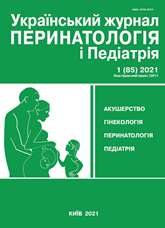Enterosorption as concomitant therapy for early toxicosis in pregnant women after assisted reproductive technologies against the background of constipation
DOI:
https://doi.org/10.15574/PP.2021.85.42Keywords:
pregnant women, assisted reproductive technologies, constipation, treatment, sorbentsAbstract
The aim is to evaluate the effectiveness of the drug «Atoxil Plus» use in the group of pregnant women after assisted reproductive technologies (ART) with early mild toxicosis against the background of constipation.
Materials and methods. The effectiveness of the drug «Atoxil Plus» (Orisil-Pharma) in 37 pregnant women with early mild toxicosis on the background of constipation was studied. The pregnant women in the study had no other comorbidities (pathology of the gastrointestinal tract, severe heart failure, infectious diseases, etc.). Taking into account that the definition of the quality of life indicator is an integral indicator of the effectiveness of treatment, the quality of life of pregnant women was assessed according to the «Gastrointestinal Simptom Rating Scale» (GSRS), a special questionnaire, before and after complex treatment of early toxicosis using the drug «Atoxil Plus». GSRS includes 15 questions to assess the following domains: the presence of abdominal pain, heartburn, constipation, diarrhea and signs of dyspepsia. The lower the results for the studied domains, the better. All pregnant women used the «Atoxil Plus» (2 g 3 times/day) for 10–14 days. Any general or local laxatives were excluded from the treatment regimen.
Results. Treatment of early pregnancy toxicosis is important, given the loss of electrolytes, microelements, water and significant deterioration in the quality of life. High sorption capacity of Atoxil Plus in relation to microorganisms and bacterial toxins, the possibility of moderate therapeutic doses use due to the large active surface area, the increased binding rate of bacteria and their toxins provide quick therapeutic effect. Against the background of the «Atoxil Plus» enterosorbent use, not only does the constipation frequency not increase, which is very important during pregnancy, but the number of bowel movements is normalized due to the presence of lactulose in the medication, especially given the significant amount of gestagens pregnant women receive after ART.
Conclusions. The non-invasive nature of the use of Atoxil Plus, its oral administration, high efficacy in pregnant women with early toxicosis, which manifests itself in improving the quality of life and general well-being, a high safety profile make it possible to recommend this drug as a treatment for early mild toxicosis against the background of constipation in pregnant women after ART.
The study was conducted in accordance with the principles of the Declaration of Helsinki. The research protocol was approved by the Local Ethics Committee of the institution mentioned in the work. Informed consent of women was obtained for the research.
The authors declare no conflict of interest.
References
ACOG. (2004). Practice Bulletin: nausea and vomiting of pregnancy. American College of Obstetrics and Gynecology. Obstet Gynecol. 103: 803-814. https://doi.org/10.1097/00006250-200404000-00045; PMid:15051578
Bradley Catherine S, Kennedy Colleen M, Turcea Anne M, Rao Satish SC, Nygaard Ingrid E. (2008). Constipation in pregnancy: prevalence, symptoms, and risk factors. Obstetrics and gynecology. 110 (6): 1351-1357. https://doi.org/10.1097/01.AOG.0000295723.94624.b1; PMid:18055731
Davyidova YuV, Limanskaya AYu, Butenko LP, Ogorodnik AA. (2016). Antiemeticheskaya terapiya rannego toksikoza u beremennyih s vrozhdennyimi porokami serdtsa. Perinatologiya i pediatriya. 3: 35-37. https://doi.org/10.15574/PP.2016.67.35
Davyidova YuV, Voloshina TV, Limanskaya AYu, Tuday VN, Dvulit MP, Baranova VV. (2014). Ranniy toksikoz beremennosti: otsenka riskov i taktika. Zdorove zhenschinyi. 6: 62-66.
El Younis CM, Abulafia O, Sh'erer DM. (2008). Rapid marked' response of severe hyperemesis gravidarum to oral erythromycin. Am J Perinatol. 15: 533-534. https://doi.org/10.1055/s-2007-994055; PMid:9890250
Furneaux EC, Langley_Evans AJ, Langley-Evans SC. (2001). Nausea and vomiting'of pregnancy: endocrine basis and contribution to pregnancy outcome. Obstet Gynecol Surv. 56: 775-782. https://doi.org/10.1097/00006254-200112000-00004; PMid:11753180
Kocak I, Akcan Y, Ustun C. (2009). Helicobacter pylon seropositivity in patients with hyperemesis gravidarum. Int J Gynaecol Obstet. 66: 251-254. https://doi.org/10.1016/S0020-7292(99)00091-0
Koch KL, Stern RM, Vascy M. (2010). Gastric dysrhythmias and nausea of pregnancy. Dig Dis Sci. 35: 961-968. https://doi.org/10.1007/BF01537244; PMid:2384042
Kаmm МА. (2006). Clinical Case: Chronic Constipation. Gastroenterology. 131: 23В3-239. https://doi.org/10.1053/j.gastro.2006.05.027; PMid:16831605
Leung L, Riutta T, Kotecha J, Rosser W. (2011). Chronic constipation: an evidence-based review. J Am Board Fam Med. 24 (4): 436-451. https://doi.org/10.3122/jabfm.2011.04.100272; PMid:21737769
Lin H, Li Y, Li L, Wang W, Zhang Q, Chen XD. (2013). Yang Oral oestradiol supplementation as luteal support in IVF/ICSI cycles: a prospective, randomized controlled study. Eur J Obstet Gynecol Reprod Biol. 167: 171-175. https://doi.org/10.1016/j.ejogrb.2012.11.026 ;PMid:23287635
Moini A, Zadeh MS, Amirchaghmaghi E, Mirghavam N, Khafri S, Reza AM, Yazdi RS. (2011). The effect of adding oral oestradiol to progesterone as luteal phase support in ART cycles - a randomized controlled study. Arch Med Sci. 7: 112-116. https://doi.org/10.5114/aoms.2011.20613; PMid:22291742 PMCid:PMC3258705
Var T, Tonguc EA, Doganay M, Gulerman C, Gungor T, Mollamahmutoglu L. (2011). A comparison of the effects of three different luteal phase support protocols on in vitro fertilization outcomes: a randomized clinical trial. Fertil Steril. 95: 985-989. https://doi.org/10.1016/j.fertnstert.2010.06.057; PMid:20674911
Downloads
Published
Issue
Section
License
The policy of the Journal “Ukrainian Journal of Perinatology and Pediatrics” is compatible with the vast majority of funders' of open access and self-archiving policies. The journal provides immediate open access route being convinced that everyone – not only scientists - can benefit from research results, and publishes articles exclusively under open access distribution, with a Creative Commons Attribution-Noncommercial 4.0 international license(СС BY-NC).
Authors transfer the copyright to the Journal “MODERN PEDIATRICS. UKRAINE” when the manuscript is accepted for publication. Authors declare that this manuscript has not been published nor is under simultaneous consideration for publication elsewhere. After publication, the articles become freely available on-line to the public.
Readers have the right to use, distribute, and reproduce articles in any medium, provided the articles and the journal are properly cited.
The use of published materials for commercial purposes is strongly prohibited.

